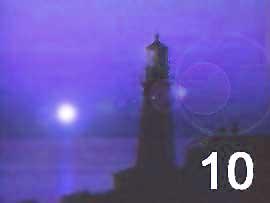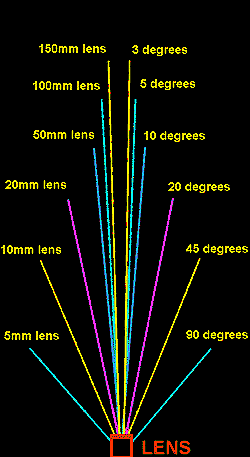|
|
Lenses: Apart from protecting it from the elements and occasionally cleaning it, most people don't think too much about a camera's lens. In actual fact, variables associated with camera lenses have a major effect on how subject matter will be seen by a viewer. The cameraperson who understands this commands a significant amount of creative power. Before we investigate how these creative controls work, we need to look at some basic information about lenses-starting with the most basic of all lens attributes: focal length. As we will see, the focal length of a lens affects the appearance of subject matter in several ways.
|
|
Zoom lenses came into common use in the early 1960s. Before then TV cameras had lenses of different focal lengths mounted on a turret on the front of the camera, as shown on the right. Each lens had to be rotated into position and focused when the camera was not on the air. Today, most video cameras use zoom lenses. Unlike the four lenses shown here, which each operate at only one focal length, the effective focal length of a zoom lens can be continuously varied, taking it from a wide-angle to a telephoto perspective. To make this possible, zoom lenses have numerous glass elements, each precisely ground, polished and positioned, which can be repositioned to change the magnification of the lens. (Note cutaway view on the right below.)
As the lens is zoomed, groups of these lens elements must move
independently at precise speeds. It might seem that we would be taking a step backwards to use a prime lens, or a lens that operates at only one focal length. Not necessarily. Some professional videographers and Directors of Photography-especially those who have their roots in film where prime lenses have typically been used-feel that prime lenses are more predictable in their results. (It also sort of depends on what you've gotten used to!) Prime lenses also come in more specialized forms-super wide-angle, super telephoto, super-fast, etc. Even so, for normal work zoom lenses are much easier and faster to use. The latest of HDTV zoom lenses are extremely sharp-almost as sharp as the best prime lenses.
Angle of view is directly associated with lens focal length. The longer the focal length (in millimeters) the narrower the angle of view (in degrees). You can see this relationship by studying the drawing on the left that shows angles of view for a typical camera lens. A telephoto lens (or a zoom lens operating at maximum focal length) has a narrow angle of view. Although there is no exact definition for a "telephoto" lens, the angles at the top of the drawing from about 5 to about 10 degrees would be considered in the telephoto range. The wide-angle range for this lens is represented at the bottom of the drawing (from about 45 to 90 degrees). The normal angle of view range lies in between telephoto and wide angle. When you double the focal length of a lens, you double the size of an image on the target; and, as you would assume, the reverse is also true.
A Zoom vs. A Dolly Another way to alter what the camera sees is to actually move (dolly) the camera toward or away from a subject. Although it might seem that this would produce the same effect as zooming the lens in and out, that's not quite true. When you zoom you optically enlarge smaller and smaller parts of the picture to fill the screen. When you dolly a camera you physically move the entire camera toward or away from subject matter. The latter is similar to how you would see the central and surrounding subject matter if you were to walk toward or away from it. Some directors, especially in motion pictures, prefer the more
natural effect of a dolly, even though it's much harder to smoothly achieve. Zoom Ratio Zoom ratio is used to define the focal length range for a zoom lens. If the maximum range through which a particular lens can be zoomed is 10 mm to 100 mm, it's said to have a 10:1 (ten-to-one) zoom ratio (l0 times the minimum focal length of 10mm equals 100mm). That's fine, but with this designation you still don't know what the minimum and maximum focal lengths are. A10:1 zoom lens could have a 10 to 100mm, or a 100 to 1,000mm lens, and the difference would be quite dramatic. To address this issue, we refer to the first zoom lens as a 10 X 10 (ten-by-ten) and the second as a 100 X 10. The first number represents the minimum focal length and the second number the multiplier. So a 12 X 20 zoom lens would have a minimum focal length of 12mm and a maximum focal length of 240mm. The zoom lenses on most handheld field cameras have ratios in the range of 10:1 to 30:1. The effect of zooming from a wide-angle position to a telephoto view with a 30:1 zoom lens is shown below.
Although one manufacturer makes a zoom lens with a 200:1 zoom ratio, the type often used for network sports have ratios of 70:1 and less. With a 70:1 zoom lens a camera covering a football game could zoom out and get a wide shot of the field, and then by zooming in, fill the screen with a football sitting in the middle of the field.
Originally, zoom lenses were manually controlled by push rods and hand cranks. Today, zoom lenses are typically controlled by built-in, variable-speed electric motors. These electric zooms are often referred to as servo-controlled zooms. Although servo-controlled lenses can provide a smooth zoom at varying speeds, manually controlled zoom lenses are often preferred for sports coverage because they can be adjusted much faster between shots. This can make the difference between getting to a new shot in time to see the critical action, or missing the shot. Although most videographers work
within the limits of the zoom lens supplied with their cameras, it's possible to
modify the focal length of most lenses (both zoom and prime lenses) by using a positive
or negative supplementary lens. These can increase or decrease
the basic focal length of a lens. Information on these can be Thus far, we've assumed that varying the focal length of a lens simply affects how close the subject matter seems to be from the camera. That's true, but as we will see in the next section, focal length also affects the subject matter in a number of other important and even dramatic ways. |
 If
all illustrations don't initially appear, it may be necessary to re-load the page.
If
all illustrations don't initially appear, it may be necessary to re-load the page.
 Zoom
and Prime Lenses
Zoom
and Prime Lenses








